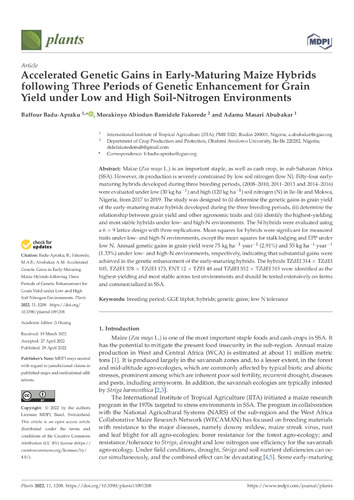Accelerated genetic gains in early-maturing maize hybrids following three periods of genetic enhancement for grain yield under low and high soil-nitrogen environments
Abstract
Maize (Zea mays L.) is an important staple, as well as cash crop, in sub-Saharan Africa (SSA). However, its production is severely constrained by low soil nitrogen (low N). Fifty-four early-maturing hybrids developed during three breeding periods, (2008–2010, 2011–2013 and 2014–2016) were evaluated under low (30 kg ha−1) and high (120 kg ha−1) soil nitrogen (N) in Ile-Ife and Mokwa, Nigeria, from 2017 to 2019. The study was designed to (i) determine the genetic gains in grain yield of the early-maturing maize hybrids developed during the three breeding periods, (ii) determine the relationship between grain yield and other agronomic traits and (iii) identify the highest-yielding and most stable hybrids under low- and high-N environments. The 54 hybrids were evaluated using a 6 × 9 lattice design with three replications. Mean squares for hybrids were significant for measured traits under low- and high-N environments, except the mean squares for stalk lodging and EPP under low N. Annual genetic gains in grain yield were 75 kg ha−1 year−1 (2.91%) and 55 kg ha−1 year−1 (1.33%) under low- and high-N environments, respectively, indicating that substantial gains were achieved in the genetic enhancement of the early-maturing hybrids. The hybrids TZdEI 314 × TZdEI 105, TZdEI 378 × TZdEI 173, ENT 12 × TZEI 48 and TZdEI 352 × TZdEI 315 were identified as the highest-yielding and most stable across test environments and should be tested extensively on farms and commercialized in SSA.

